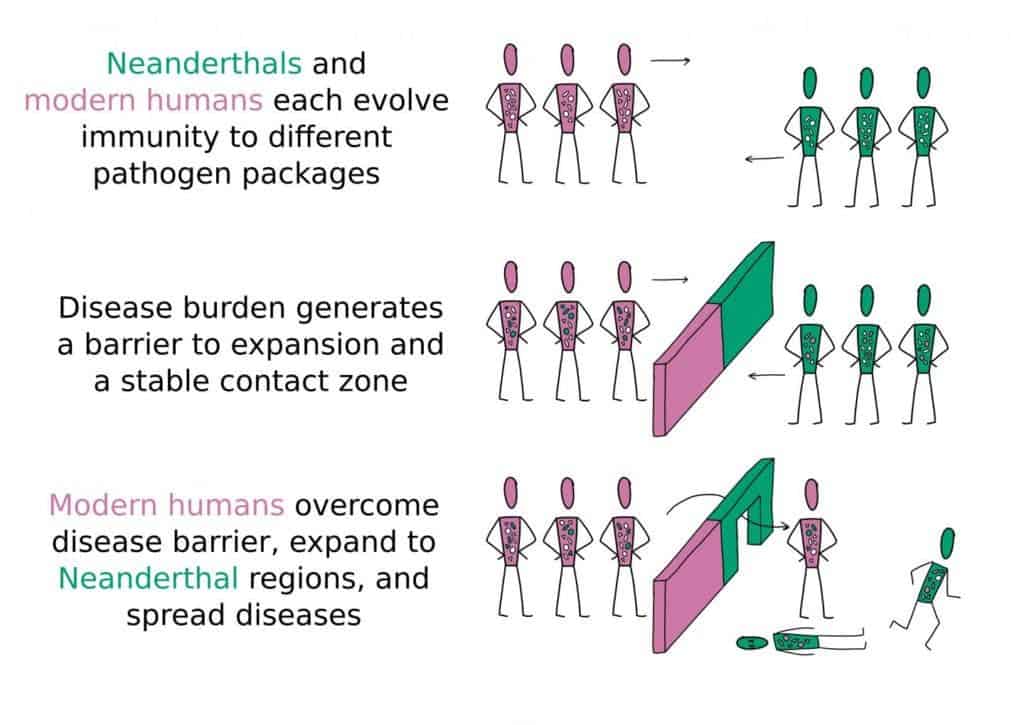
Our extinct cousins, the Neanderthals, seem to have been just as intelligent, resourceful, and culturally sophisticated as modern humans during the paleolithic era. About 40,000 years ago, their species abruptly disappeared while Homo sapiens went on to not only survive but flourish.
What could have caused the Neanderthals to disappear? Were they ill-adapted for climate change? Did competition for resources with humans drive them to extinction? Research suggests that both climate change and competition may have played an important part in the Neanderthals’ demise — and a new study suggests that disease transmission from humans sealed their fate.
Based on archaeological evidence, researchers believe that Neanderthals and modern humans first made contact around 130,000 years ago in the Levant, an Eastern Mediterranean region.
This means that the two species coexisted for thousands of years. In fact, there is ample evidence of interbreeding, and even today most people of non-Sub-Saharan heritage have up to 4% Neanderthal DNA. But, if that’s the case, why did Neanderthals eventually go extinct?
Gill Greenbaum and colleagues at Stanford believe that the key to answering such a question lies in disease transmission patterns.
“Our research suggests that diseases may have played a more important role in the extinction of the Neanderthals than previously thought. They may even be the main reason why modern humans are now the only human group left on the planet,” said Greenbaum, who is the first author of the study and a postdoctoral researcher in Stanford’s Department of Biology.
Disease transmission between different populations that had been isolated from one another flows both ways since each population has adapted immunity to distinct pathogens. Greenbaum’s team employed a mathematical model of disease transmission and gene flow that showed that disease exchange between the two species must have created a narrow contact zone in the Levant. This disease barrier must have kept the two species in check for thousands of years, preventing both humans and Neanderthals from venturing too far into each others’ territory.
This stalemate couldn’t last forever, and what eventually gave humans an edge may have been interbreeding. Hybrids born out of the union of the two species likely carried immune-related genes from both humans and Neanderthals. In time, the disease burden or risk of infection with both groups gradually lifted, allowing modern humans with Neanderthal DNA to venture far beyond the Levant, into fresh Neanderthal territory which our species had no previous contact with.
Once this disease burden threshold was crossed, perhaps other advantages that humans had over the Neanderthals — such as more sophisticated weapons and social structure — became overpowering.

Greenbaum also argues that our ancestors also carried a greater disease burden. Since humans came from Africa, they must have carried a suite of tropical diseases that were likely deadlier, more diverse, and more numerous than those carried by Neanderthals, which had adapted to diseases in the temperate region.
Employing a new mathematical model, the researchers showed that even slight differences in disease burden between the two groups would result in compound growth over time.
“It could be that by the time modern humans were almost entirely released from the added burden of Neanderthal diseases, Neanderthals were still very much vulnerable to modern human diseases,” Greenbaum said. “Moreover, as modern humans expanded deeper into Eurasia, they would have encountered Neanderthal populations that did not receive any protective immune genes via hybridization.”
Disease transmission can easily decimate populations, as evidenced by the numerous plagues that have killed millions in fairly recent history. Then there’s the case of Europeans who, although they arrived in feeble number in the Americas in the 15th and 16th-century, simply wiped out local populations that didn’t have enough time to adapt to the invasive pathogens brought from overseas.
But, although Greenbaum’s theory is highly plausible, it needs to be supported by evidence. The scientist hopes to find some in the archaeological record.
“We predict, for example, that Neanderthal and modern human population densities in the Levant during the time period when they coexisted will be lower relative to what they were before and relative to other regions,” Greenbaum said.
The findings appeared in the journal Nature Communications.






